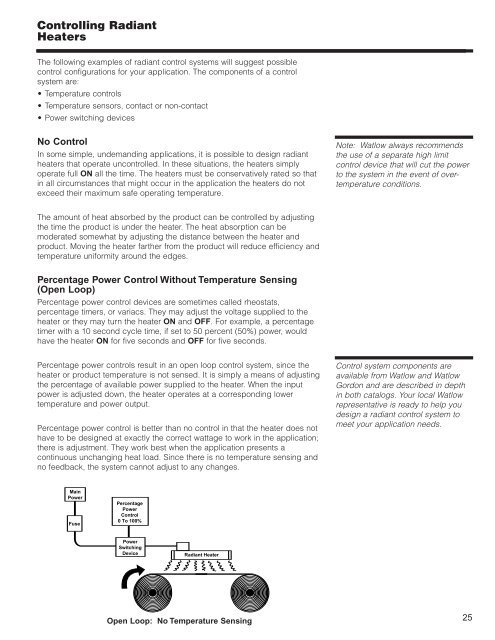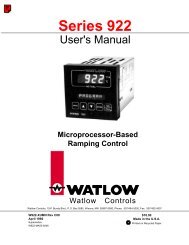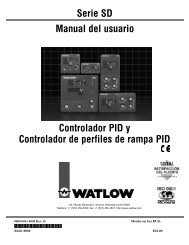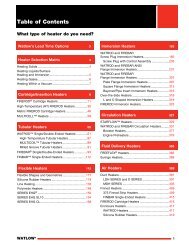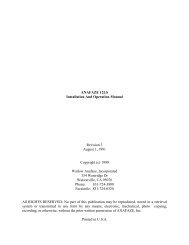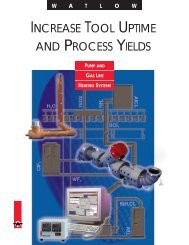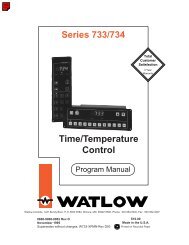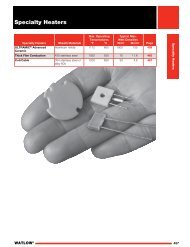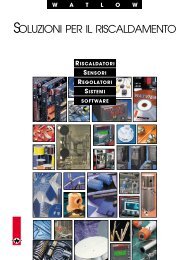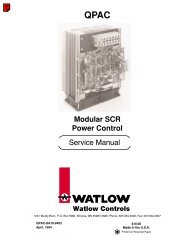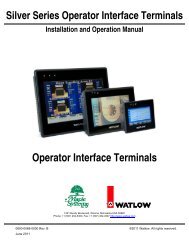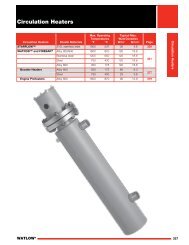RADIANT HEATING WITH INFRARED - Watlow
RADIANT HEATING WITH INFRARED - Watlow
RADIANT HEATING WITH INFRARED - Watlow
Create successful ePaper yourself
Turn your PDF publications into a flip-book with our unique Google optimized e-Paper software.
Controlling Radiant<br />
Heaters<br />
The following examples of radiant control systems will suggest possible<br />
control configurations for your application. The components of a control<br />
system are:<br />
• Temperature controls<br />
• Temperature sensors, contact or non-contact<br />
• Power switching devices<br />
No Control<br />
In some simple, undemanding applications, it is possible to design radiant<br />
heaters that operate uncontrolled. In these situations, the heaters simply<br />
operate full ON all the time. The heaters must be conservatively rated so that<br />
in all circumstances that might occur in the application the heaters do not<br />
exceed their maximum safe operating temperature.<br />
The amount of heat absorbed by the product can be controlled by adjusting<br />
the time the product is under the heater. The heat absorption can be<br />
moderated somewhat by adjusting the distance between the heater and<br />
product. Moving the heater farther from the product will reduce efficiency and<br />
temperature uniformity around the edges.<br />
Percentage Power Control Without Temperature Sensing<br />
(Open Loop)<br />
Percentage power control devices are sometimes called rheostats,<br />
percentage timers, or variacs. They may adjust the voltage supplied to the<br />
heater or they may turn the heater ON and OFF. For example, a percentage<br />
timer with a 10 second cycle time, if set to 50 percent (50%) power, would<br />
have the heater ON for five seconds and OFF for five seconds.<br />
Percentage power controls result in an open loop control system, since the<br />
heater or product temperature is not sensed. It is simply a means of adjusting<br />
the percentage of available power supplied to the heater. When the input<br />
power is adjusted down, the heater operates at a corresponding lower<br />
temperature and power output.<br />
Percentage power control is better than no control in that the heater does not<br />
have to be designed at exactly the correct wattage to work in the application;<br />
there is adjustment. They work best when the application presents a<br />
continuous unchanging heat load. Since there is no temperature sensing and<br />
no feedback, the system cannot adjust to any changes.<br />
Main<br />
Power<br />
Fuse<br />
Percentage<br />
Power<br />
Control<br />
0 To 100%<br />
Power<br />
Switching<br />
Device<br />
Radiant Heater<br />
Open Loop: No Temperature Sensing<br />
Open Loop: No Temperature Sensing<br />
Note: <strong>Watlow</strong> always recommends<br />
the use of a separate high limit<br />
control device that will cut the power<br />
to the system in the event of overtemperature<br />
conditions.<br />
Control system components are<br />
available from <strong>Watlow</strong> and <strong>Watlow</strong><br />
Gordon and are described in depth<br />
in both catalogs. Your local <strong>Watlow</strong><br />
representative is ready to help you<br />
design a radiant control system to<br />
meet your application needs.<br />
25


